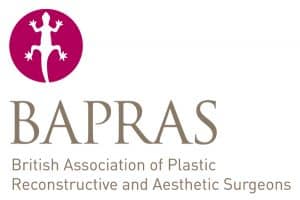
Breast Procedures
Breast Reduction
10 Harley Street
London W1G 9PF
Breast Reduction
Breast reduction (reduction mammoplasty) is a surgical procedure aimed at reducing the size/volume, reshaping (lifting) the breasts and repositioning the nipple areola complex. It involves removing excess breast tissue, fat and skin to achieve a more proportionate size and alleviate issues such as back pain, neck pain, and discomfort associated with overly large breasts.
What determines the bra cup size?
Cup size is a common reference point when patients describe their goals for breast reduction and describes the relationship of breast girth to chest girth.
If breast girth exceeds chest girth by 1 inch, the cup size is an A; 2 inches is a B; 3 inches is a C; 4 inches is a D, and 5 inches is a DD.
What is the difference between anchor and lollipop breast reduction?
A lollipop incision is a less extensive surgical approach compared to the anchor-shape incision. The incision starts by encircling the areola (area of brown skin surrounding the nipple) and continues in a straight line down to the breast crease but does not include the horizontal incision in the breast crease that the anchor method does.
Different techniques are also available to reposition the Nipple Areola complex during breast reduction surgery. The various techniques (superior, inferior, medial Pedicle techniques) are named based on where the blood supply to the nipple comes from.
In breast reduction, the pedicle is a bridge of tissue used to bring blood and nerve supply to the nipple when the tissue around it has been removed.
Breast reduction surgery can provide relief from the physical discomfort and the emotional issues associated with having unusually large breasts. This surgery can improve your health by relieving chronic back, neck and shoulder pain, as well as improving the shape and firmness of your breasts. Following breast reduction, your breasts will be more proportionate to the rest of your body and many women experience greater self-esteem.
(It is worth mentioning that a post-reduction mammogram 6 -12 months after reduction should be performed in order to establish a new baseline image for future comparison).
Breast Reduction Case Study
To book a consultation call 07943 277 215 or email clinic@lindafiumara.com
Breast Procedures
Breast Reduction
Breast Reduction
Breast reduction (reduction mammoplasty) is a surgical procedure aimed at reducing the size/volume, reshaping (lifting) the breasts and repositioning the nipple areola complex. It involves removing excess breast tissue, fat and skin to achieve a more proportionate size and alleviate issues such as back pain, neck pain, and discomfort associated with overly large breasts.
What determines the bra cup size?
Cup size is a common reference point when patients describe their goals for breast reduction and describes the relationship of breast girth to chest girth.
If breast girth exceeds chest girth by 1 inch, the cup size is an A; 2 inches is a B; 3 inches is a C; 4 inches is a D, and 5 inches is a DD.
What is the difference between anchor and lollipop breast reduction?
A lollipop incision is a less extensive surgical approach compared to the anchor-shape incision. The incision starts by encircling the areola (area of brown skin surrounding the nipple) and continues in a straight line down to the breast crease but does not include the horizontal incision in the breast crease that the anchor method does.
Different techniques are also available to reposition the Nipple Areola complex during breast reduction surgery. The various techniques (superior, inferior, medial Pedicle techniques) are named based on where the blood supply to the nipple comes from.
In breast reduction, the pedicle is a bridge of tissue used to bring blood and nerve supply to the nipple when the tissue around it has been removed.
Breast reduction surgery can provide relief from the physical discomfort and the emotional issues associated with having unusually large breasts. This surgery can improve your health by relieving chronic back, neck and shoulder pain, as well as improving the shape and firmness of your breasts. Following breast reduction, your breasts will be more proportionate to the rest of your body and many women experience greater self-esteem.
(It is worth mentioning that a post-reduction mammogram 6 -12 months after reduction should be performed in order to establish a new baseline image for future comparison).
Breast Reduction
Case Study
As featured in The Evening Standard and The Telegraph –










Copyright © 2023 Dr Linda Fiumara MD
Designed by Createch
